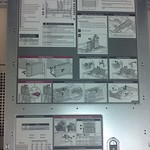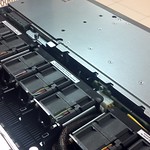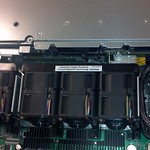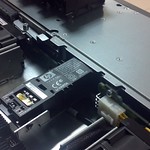A couple of weeks ago, I tweeted about a server that had a blinking health light. After some poking around, I discovered that WBEM was reporting everything was A-OK with the server, but flipping the management tools to using SNMP reported a memory failure.
 After scheduling some down time to replace the memory, I went to slide the server out on the rails, and discovered that the HP ProLiant DL585 G1 series servers has the health status board on the top of the chassis. This confused me because all the other servers we have have either a pop out tray with the information on, or some kind of LCD up from that reports the status.
After scheduling some down time to replace the memory, I went to slide the server out on the rails, and discovered that the HP ProLiant DL585 G1 series servers has the health status board on the top of the chassis. This confused me because all the other servers we have have either a pop out tray with the information on, or some kind of LCD up from that reports the status.
 What caught me by surprise was the fact that the server had the full hardware layout instructions on the top of the server. It’s been a long time since I’ve seen this. Granted it is an old server (G1 class servers are getting a little long in the tooth), but it was nice to see the full details right where I needed them, and not having to go hunting through HPs terrible support site for the details.
What caught me by surprise was the fact that the server had the full hardware layout instructions on the top of the server. It’s been a long time since I’ve seen this. Granted it is an old server (G1 class servers are getting a little long in the tooth), but it was nice to see the full details right where I needed them, and not having to go hunting through HPs terrible support site for the details.
 What’s even more interesting to me was the hardware health status board. On the newer servers, this is usually smaller than a credit card, and about as thick as 3 quarters stacked on top of each other. In this DL585, the board is the size of a large network card, with multiple LEDs feeding clear plastic shafts that pipe to another set on the bottom of the chassis top.
What’s even more interesting to me was the hardware health status board. On the newer servers, this is usually smaller than a credit card, and about as thick as 3 quarters stacked on top of each other. In this DL585, the board is the size of a large network card, with multiple LEDs feeding clear plastic shafts that pipe to another set on the bottom of the chassis top.
I find it interesting to see how hardware configurations have grown, and changed over time, even the very small things. I don’t see many servers with instructions on any more, probably a money saver for the vendors. I also don’t see much in the way of big health boards any more, managing to squeeze so much into a tiny board now. The advancement in chips and technologies has made the server realm quite interesting to poke around in.


